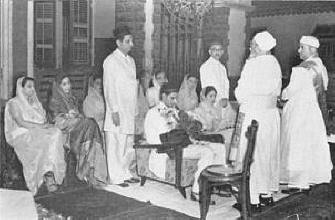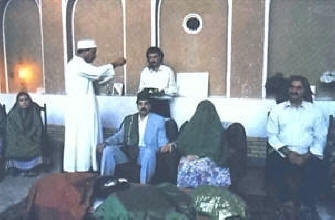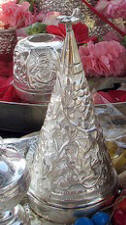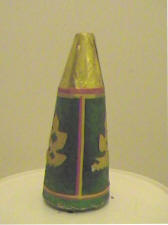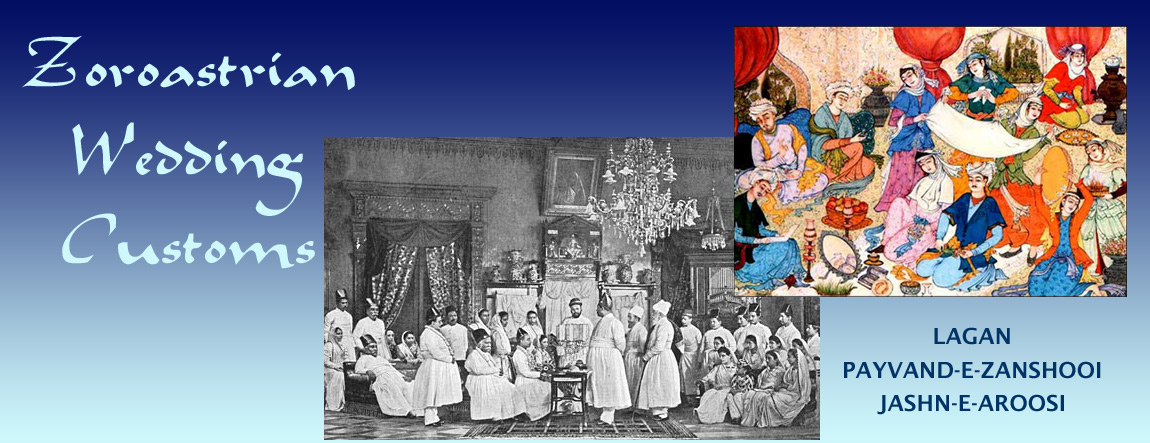
Contents
Zoroastrian Wedding Customs
Introductory Page
Indian Zoroastrian (Parsi & Irani)
Page1
Engagement
Page2
Pre-Wedding Festivities
Page3
Wedding Day
Page4
Marriage & Reception
Iranian Zoroastrian
Page 1
Yazdi Wedding Customs
Page 2
Modern Iranian Wedding Customs
Introductory Page
» Indian Zoroastrian Wedding (Lagan) Customs
» Iranian Zoroastrian Wedding (Aghd & Jashne Aroosi) Customs
|
[For an explanation on the use of group names such as Parsi and Irani, see the page: Demographics and Group Names.]
Diversity in Customs
Shared Core Values
Zoroastrian weddings customs are a blend of dignity and fun. Imbedded in their rites are millennia of tradition interspersed with modern customs borrowed from other cultures. There are differences in marriage customs that stem from the regions from which the couple and their families originate. And there are differences depending on the extent of orthodoxy the organizers wish to maintain.
Whether it was as a result of the influence of the majority communities among which Zoroastrians are minorities, or the Persians' historic penchant of adopting and adapting the customs of others (be it the customs of Urmia, Susa and Elam into whose territories they migrated, Greek customs and later British customs), Zoroastrians have readily incorporated the customs of the majority communities with whom they dwell, into their marriage rites.
However, the differences in customs that result from these adapted local customs are superficial. Peel away the cultural layers and you will uncover a common ethic, a set of core values, and a shared spiritual flame that is distinctly Zoroastrian - all preserved through eons in a manner that is truly remarkable.
Evolution of Wedding Customs
In addition to the incorporation of customs from other cultures, Zoroastrian wedding customs have also evolved.
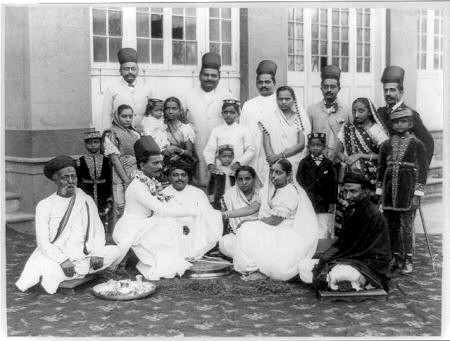 |
| Indian-Zoroastrian wedding 1898 CE Photo at US Library of Congress' Frank and Frances Carpenter Collection Photograph by Bourne & Shepherd, Bombay Photo shows a blend of Zoroastrian and Hindu elements. Couples and witnesses seated on a low stool - the patlo. Note the couples' hand under the sheet - hathevaro Contrast the setting with other photos elsewhere on these pages |
The photograph at right is from a ceremony in India approximately a hundred years ago. Compare it with photographs elsewhere in pages and you will notice an evolution in particular aspects of the customs.
For instance, nowadays, the couple getting married sit on chairs, while in the past all Zoroastrian ceremonies were performed sitting on the floor or on a low stool called a patlo (also see the navjote ceremony).
Another example of both an evolution and a cultural difference in the customs is the form of the rock sugar cone used as one of the symbolic items in the marriage ceremony. In the Iranian province of Yazd, the rock sugar is wrapped in green foil. Modern Iranian weddings, dress the sugar in white lace, and in India, the rock sugar is placed within a metal container called a soparo. In India, the rock sugar may be absent altogether - merely represented by the metal cone or soparo.
|
Differences in Wedding Customs
Cultural differences, differences within a culture, variations between local customs, a family's preferences, compromises made by the two families involved, as well as individual idiosyncrasies, result in a wedding ceremony that is unique to that occasion. However, there are some broad differences between wedding customs based in Iran and India.
Differences in Iranian & Indian (Parsi or Parsee & Irani) Wedding Customs
While the religious underpinnings for the two main cultural groups are the same, the manner in which Iranian and Indian (Parsi or Parsee and Irani) Zoroastrians interpret their shared religious beliefs in ritual, dress, accessories and food, is heavily influenced by the cultures of the majority populations in Iran and India respectively.
As a result, we have described the Iranian and Indian wedding customs separately in these pages.
Differences within Iranian Wedding Customs. Yazdi Wedding customs
Marriages involving couples and families from the capital of Iran, Tehran, can be expected to be more westernized than marriages in, say, the smaller towns in the province of Yazd, where the marriages can be expected to be more traditional. Yazd is a central province in Iran and home to the largest population of Iranian Zoroastrians who resisted conversion to Islam.
For instance, orthodox Zoroastrians in Yazd may not use a sheet called the sofreh aghd during a wedding ceremony. The sofreh aghd is a white sheet spread on the floor in front of the couple during a marriage ceremony, and on which are placed ritual and symbolic items.
The sofreh aghd is commonly used by Muslim Iranians who will tell you that the spread is entirely Zoroastrian in its origins and symbolism. Indeed, sheets placed on the floor form the sacred space in all Zoroastrian ceremonies. Nowadays, while Indian Zoroastrians do place a sheet on the floor to define the sacred space, they place chairs on top of the sheet, and all the symbolic and ritual items are placed on tables rather than on the sheet.
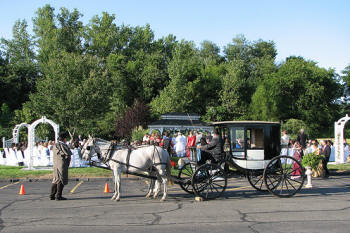 |
| North American Zoroastrian wedding |
New World Wedding customs
It is only a matter of time before Zoroastrians in Europe, North America, Australia, New Zealand and other new world countries - who may or may not have origins in India and Iran - develop their own particular style of marriage ceremonies, a process that is already underway as you may notice in the coming pages.
Other Old World Zoroastrian Wedding Customs
For the time begin, we have not included here wedding customs of Zoroastrians from places such as Kurdistan and Tajikistan, places with cultures that have equal claim to Zoroastrian roots and whose customs reflect their own rich history. The Zoroastrians from these regions are only now coming to our consciousness and we look forward to discovering and including these cultural treasures.
Divorce
Zoroastrian marriage vows are made for the life of the couple. Zoroastrians of old were noted for keeping their word. Their word was their bond. Any promise in Zoroastrianism is a sacred act, under the guardianship of the angel Mithra who is one of the angels who greets the souls upon its transition to the spiritual existence after death. At that juncture, Mithra presents the soul the promises it has kept and broken, a factor in determining the fate of the soul. Divorce is a breaking of the marriage vows.
Barely fifty years ago, divorce amongst Zoroastrians was rare. If a disagreement or conflict arose between a couple, the families, especially the elders and priests played a significant role in resolving the conflict. Until recently, divorce, if unavoidable, brought shame and dishonour to families.
Nowadays, while divorce between Zoroastrians is slowly becoming more frequent, the incidence of divorce between Zoroastrian couples is probably less than the rate in other communities. Regardless, for orthodox Zoroastrians, divorce is not an option.
It behoves Zoroastrians to enter into marriage - and to take the marriage vows - after careful consideration. Parents have a critical role in introducing some objectivity into the decision for a couple to wed.
Wedding Costs
Older conventions, for instance the bride's parents paying for the wedding, are changing. Nowadays one finds all options being explored by a prospective couple and their families. Whatever method they may choose, the guiding principles are to organize an event that is affordable - an event that does not cause either the parents or the couple to go into debt. Certainly, for the couple to start their life together in debt is considered unwise and even foolish. Generally, Zoroastrians think very carefully before borrowing money and feel that being beholden to anybody, even an impersonal bank, limits one's sovereignty and independence. Borrowing, especially excessive borrowing, can result in dishonest practices and the breaking of contracts - all of which are antithetical to Zoroastrian ethics. Corollary guiding principles are to live within one's means, to be independent, self-sufficient and self-supporting.
If the parents, separately or together, can well afford to pay for the wedding, they will usually offer to do so. They will lead the wedding planning while respecting and accommodating as best as possible, the wishes of the couple-to-be. They will also marshal the assistance of the entire family. Doing so, allows the couple to keep the gift money and use it towards building a life together. If the parents cannot afford to pay for the wedding, cash gifts are usually sufficient to cover basic wedding costs.
 |
» Indian Zoroastrian Wedding Customs
» Iranian Zoroastrian Wedding Customs
